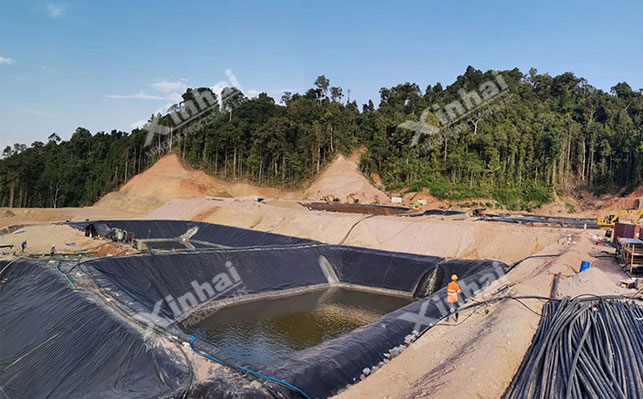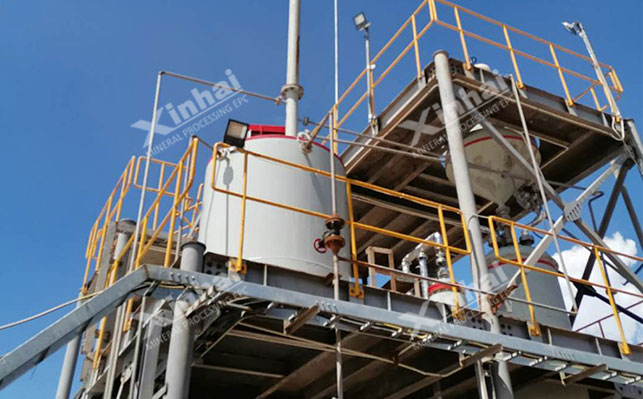The gold ore leaching technology is a simple and easy method for gold extraction, which has the advantages of less investment, fast start-up, and low cost. So what is the process flow of the gold ore leaching technology, and what type of gold ore is the pool leaching method suitable for?

Gold pool leaching is generally carried out in percolation leaching ponds. Wooden ponds, iron troughs or cement ponds are usually used as the leaching ponds. The pool is equipped with a false bottom made of acid-resistant board with holes and covered with filter cloth, and the filter cloth is covered with a grid with wooden strips or corrosion-resistant metal strips. During leaching, the ore is placed in the pool; the leaching agent is then added above the pool, and the leaching liquid flows out from the lower part of the false bottom. The false bottom is used to filter and support the ore.
The process flow of pool leaching is as follows: the gold-bearing ore crushed to a certain particle size is loaded into the leaching pool, and the alkaline cyanide solution is added for leahing, and the gold is dissolved into the solution. After leaching for a certain period of time, the concentration and grade of the liquid meet the requirements. At this time, the gold-containing solution (pregnant liquid) is released from the bottom of the pool, replaced with zinc flakes (powder) (can also be adsorbed by activated carbon) to recover the gold. The leaching residue is discarded after decontamination. Sodium sulfite, copper sulfate, etc. can be added to remove cyanide from the leaching residue for cyanide removal.
PS: The time required for leaching in the percolation tank is not only determined by the dissolution rate of the solvent to the minerals, but also closely related to the penetration rate of the solvent in the material layer. The penetration rate mainly depends on factors such as the height of the material, the porosity of the material, the degree of sludge content, the viscosity of the leaching agent, and the characteristics of the material itself.

Here we take a 700t/d pool leaching project in India undertaken by Xinhai as an example to briefly introduce the technological process. Based on the results of beneficiation experiments, Xinhai Mining has designed the process flow of crushing and screening - tank leaching - adsorption - desorption electrolysis - activated carbon pickling and regeneration - smelting for this project. The detailed process is as follows:
1. Crushing and washing operation
YTS1550 cylindrical screen is used to wash the ore, and the large pieces on the screen are crushed by PC1000*1200 crusher. After crushing and washing the raw ore smaller than 150mm, the mineral particle size of ≤5mm is obtained, and the concentration is about 35%, which is transported to the leaching tank through the alloy pump.
2. Carbon adsorption operation
The amount of pregnant liquid is about 40m³/h, which is transported to 3 sets of Φ1000*3000 adsorption columns through chemical pumps.
3. Adsorption operation of medium liquid and barren liquid
After the adsorption, the middle liquid enters the middle liquid tank, and is circulated through the chemical pump. The fully adsorbed lean liquid enters the barren liquid tank regularly, and is discharged after removing the cyanide ions.
4. Desorption electrolysis operation
The gold-loaded carbon was processed with a 1000kg/batch desorption electrolysis system.
5. Carbon acid washing - regeneration operation
Activated carbon pickling and regeneration system is adopted, and its processing capacity is matched with desorption and electrolysis system.
6. Smelting operation
After smelting treatment, gold ingots with a purity higher than 80% are obtained.

The gold ore pool leaching method is suitable for the ore with relatively fine grain size, low grade or ultra-low grade (such as 0.5g/t), and poor permeability. If the above three points are satisfied at the same time, the pool leaching method can be selected to extract gold. Such as: iron oxide cap type ores containing fine-grained gold and oxide quartz veins containing fine-grained gold ores.
The pool leaching gold extraction method is suitable for low-grade gold and silver ores, tailings, and gold ores with low clay content, and the beneficiation recovery rate can reach 50%~70%. The cost is slightly lower, which can improve low-grade gold mines with low economic benefits, simple operation, and low personnel cost.
However, the initial construction cost of the pool leaching gold method is relatively high and the leaching time is relatively long, because it is necessary to build a leaching pool and a barren liquid pool to ensure that the pool is basically dry without leaking, and then the ore is placed in the leaching pool, and the leaching solution is prepared in the barren liquid pool. Then, the leaching solution is pump into the leaching tank for leaching, and you can release the pregnant solution for replacement after a period of time.